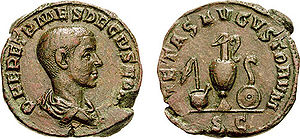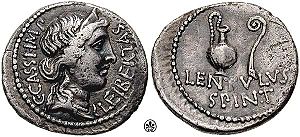
Lituus
Encyclopedia


Latin
Latin is an Italic language originally spoken in Latium and Ancient Rome. It, along with most European languages, is a descendant of the ancient Proto-Indo-European language. Although it is considered a dead language, a number of scholars and members of the Christian clergy speak it fluently, and...
language. In English it is used with several meanings.
Roman ritual wand
The lituus was a crooked wand (similar in shape to the top part of a crosierCrosier
A crosier is the stylized staff of office carried by high-ranking Catholic, Eastern Orthodox, Anglican, and some Lutheran and Pentecostal prelates...
) used as a cult instrument in ancient Roman religion by augur
Augur
The augur was a priest and official in the classical world, especially ancient Rome and Etruria. His main role was to interpret the will of the gods by studying the flight of birds: whether they are flying in groups/alone, what noises they make as they fly, direction of flight and what kind of...
s to mark out a ritual space in the sky (a templum). The passage of birds through this templum indicated divine favor or disfavor for a given undertaking.
The lituus was also used as a symbol of office for the college of the augurs to mark them out as a priestly group.
Ancient lituus
The ancient lituus was an old EtruscanEtruscan civilization
Etruscan civilization is the modern English name given to a civilization of ancient Italy in the area corresponding roughly to Tuscany. The ancient Romans called its creators the Tusci or Etrusci...
high-pitched
Pitch (music)
Pitch is an auditory perceptual property that allows the ordering of sounds on a frequency-related scale.Pitches are compared as "higher" and "lower" in the sense associated with musical melodies,...
brass instrument
Brass instrument
A brass instrument is a musical instrument whose sound is produced by sympathetic vibration of air in a tubular resonator in sympathy with the vibration of the player's lips...
, which was bent at the end, similar to the Gallic carnyx
Carnyx
The carnyx was a wind instrument of the Iron Age Celts, used between c. 300 BC to 200 AD. It was a type of bronze trumpet, held vertically, the mouth styled in the shape of a boar's, or other animal's, head. It was used in warfare, probably to incite troops to battle and intimidate opponents...
. It was later used by the Romans, especially for processional music and as a signalling horn in the army. In 17th century Germany a variant of the bent ancient lituus was still used as a signalling horn by nightwatchmen.
Mediaeval lituus
The mediaeval lituus was a different brass instrument than the ancient Etruscan instrument, described by Kürzinger (1763) as a variant of the early trumpetTrumpet
The trumpet is the musical instrument with the highest register in the brass family. Trumpets are among the oldest musical instruments, dating back to at least 1500 BCE. They are played by blowing air through closed lips, producing a "buzzing" sound which starts a standing wave vibration in the air...
or horn
Natural horn
The natural horn is a musical instrument that is the ancestor of the modern-day horn, and is differentiated by its lack of valves. It consists of a mouthpiece, some long coiled tubing, and a large flared bell. Pitch changes are made through a few different techniques:* Modulating the lip tension as...
, i.e. a later development of the ancient Roman tuba
Roman tuba
The tuba of ancient Rome is a military signal trumpet, quite different from the modern tuba. The tuba was produced around 500 BC. Its shape was straight, in contrast to the military buccina or cornu, which was more like the modern tuba in curving around the body. Its origin is thought to be...
. One of the last compositions orchestrated for the mediaeval lituus was Bach's
Johann Sebastian Bach
Johann Sebastian Bach was a German composer, organist, harpsichordist, violist, and violinist whose sacred and secular works for choir, orchestra, and solo instruments drew together the strands of the Baroque period and brought it to its ultimate maturity...
motet
Motet
In classical music, motet is a word that is applied to a number of highly varied choral musical compositions.-Etymology:The name comes either from the Latin movere, or a Latinized version of Old French mot, "word" or "verbal utterance." The Medieval Latin for "motet" is motectum, and the Italian...
O Jesu Christ, meins Lebens Licht (BWV 118). Scientists from Edinburgh University tried to recreate the lituus in May 2009, when the instrument had been out of use for 300 years.

